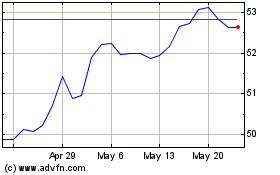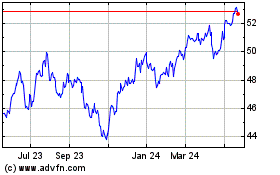As domestic markets and European economies continue to sputter,
growth in equities becomes harder to come by. In light of this, a
look at quickly growing emerging markets could be ideal for some
investors who have a higher risk tolerance at this time.
Not only do these nations have greater growth potential, but
they often have lower levels of correlation with their developed
market counterparts. Additionally, banking securities tend to be
more focused at home than abroad, suggesting low levels of exposure
to the European debt debacle as well (see more on ETFs at the
Zacks ETF Center).
Luckily for investors, the ETF industry has made it extremely
easy to play this slice of the market in a number of ways. There
are now literally dozens of funds with either a regional focus, or
even country specific products as well, that can give investors the
opportunity to target with impressive ability any market segment
that they so choose.
However, many large cap emerging market ETFs have high levels of
concentration in just a few sectors. For example, two of the most
popular funds in this segment, the SPDR S&P BRIC 40 ETF
(BIK) and the iShares MSCI BRIC Index Fund
(BKF), both have about half of their assets in two
segments; financials and energy (read Top Three BRIC ETFs).
Obviously, this might not be ideal for many as it avoids a
number of potentially high growth sectors and leaves a portfolio
heavily dependent on just a few slices of an economy. In order to
avoid this, investors could be better off looking at small cap
emerging market ETFs instead.
ETFs in this segment focus on pint sized securities across the
developing world, irrespective of sector, much like their large cap
counterparts. Yet, unlike their large cap brethren, small caps
often have a more spread out holding profile which usually includes
more assets in consumer or industrial sectors (see Three Overlooked
Emerging Market ETFs).
Additionally, small caps are often capable of higher levels of
growth than large caps, a situation which can be especially
important in the low growth world we find ourselves in today.
Yet with that being said, investors should note that these
products can experience levels of volatility that can make large
caps emerging stocks seem stable in comparison. Risk tolerance
should be very high for those looking to make a play on this space
as huge gains and losses can come in a very short period of
time.
Nevertheless, for investors who are willing to juice up risk
levels in hopes of achieving higher growth rates in a section of
their portfolio, any of the four small cap emerging market ETFs we
have highlighted below could be an excellent choice:
SPDR S&P Emerging Market Small Cap ETF (EWX)
This ETF tracks the S&P Emerging Markets Under USD2 Billion
Index in order to give investors exposure to a basket of small cap
stocks across various developing nations. The product has proven to
be extremely popular with investors as just over $900 million is
under management in the fund while trading volume is close to
105,000 shares a day.
Expenses in this ETF are moderate—low compared to some of the
more specialized products in the space but high when you put it
against the low cost options—at about 65 basis points a year.
However, the decent annual yield of 1.65% should help to defray
some of these costs for most investors.
In terms of a portfolio, EWX holds just over 810 securities in
its basket and doesn’t allocate more than 0.8% to any one stock in
particular. This suggests that the product is well diversified from
an individual security perspective and is unlikely to face company
specific risk (read Three Emerging Market ETFs To Limit BRIC
Exposure).
The top three sectors are industrials, technology, and consumer
cyclical, while energy and financials combine to make up just 12%
of the total. For countries, Taiwan takes the top spot at 28% of
assets, followed by 10% to China, 9%, in South Africa, and an 8%
allocation to India.
WisdomTree Emerging Markets SmallCap Dividend Fund
(DGS)
For a dividend-focused approach in the emerging market small cap
ETF space, a closer look at DGS could be warranted. The fund tracks
the WisdomTree Emerging Markets Small Cap Dividend Index which
looks to focus on the bottom 10% of total market cap of the
WisdomTree Emerging Markets Dividend Index, weighting firms based
on annual cash dividends paid.
This produces a fund that pays out a solid dividend yield of
roughly 3.5% a year, a good level considering the focus of the
fund. Investors should also note that over $1 billion is under
management in the fund and that both expenses are reasonable
(0.63%) and volume is high (163,000 shares per day).
However, the product does hold fewer securities than many of its
counterparts at just over 525 in total. Thanks to this, and the
dividend weighting, the product does have a higher concentration in
some of its top securities (see Top Three Emerging Market Consumer
ETFs).
In terms of sectors, this small cap ETF is tilted towards
industrials (20%), consumer cyclicals (14%), and technology (13%).
However, financials and energy do combine to make up 15% of the
fund although most of this allocation goes towards the financial
space.
The country breakdown is similar to EWX as Taiwan (26%) takes
the top spot although South Africa, and Thailand round out the top
three.
iShares MSCI Emerging Markets Small Cap Index Fund
(EEMS)
Market leader iShares’ entrant in the space is EEMS, a fund that
has had some trouble gaining assets under management. AUM is still
below $20 million in the fund promoting a weak level of volume and
loose bid ask spreads. It also doesn’t help that the product had a
higher expense ratio coming in at 69 basis points a year (see
Frontier Market ETF Investing 101).
In terms of the portfolio, the ETF does hold over 630 stocks in
its basket and does not put more than 0.6% in any single firm.
Investors should also note that the fund has a significant holding
in mid cap securities although small and micro caps do combine to
make up about 45% of the portfolio.
Sector exposure in this fund is also tilted towards different
sectors than what investors see in many large cap funds as consumer
cyclical (17%), industrials (16%), and technology (15%), take the
top three spots. Financials and energy, on the other hand, account
for a modest 10% of the assets in this product, suggesting it could
be a decent compliment to a large cap fund from this
perspective.
Although the fund may have low volume, it truly shines in the
country exposure department. Taiwan makes up less than 20% of the
assets in this product, followed by a modest 15% allocation to
South Korea and 8% allocations to both South Africa and India.
First Trust Emerging Markets Small Cap AlphaDEX Fund
(FEMS)
The newest choice in the small cap emerging market ETF space is
FEMS from First Trust. The product debuted in February and thus
hasn’t really had a chance to build up assets yet. However, the
cost could be prohibitive as it does charge investors 80 basis
points a year in fees.
The added cost could be worth it for some, especially if you
believe in the AlphaDEX methodology. This process takes a broad
benchmark of emerging market stocks and ranks them by both growth
and value characteristics.
Then, (roughly) top 200 stocks are then included in the fund,
broken down by quintiles. The top quintiles receive a higher weight
than the lower ranked ones, and stocks are equaled weighted within
their five groups. This approach can potentially produce a value
fund as the PE is currently below 8.5 on the holdings while the P/B
is at 1.30 (read Five Emerging Market Infrastructure ETFs For The
Coming Boom).
Nevertheless, the product does have a similar holdings breakdown
in terms of sectors, as consumer cyclical firms account for 19% of
assets while industrials, and basic materials round out the top
three. It also appears to be a good way to avoid exposure to the
sectors popular in large caps, as financials and energy combine to
make up just 6% of assets.
Country exposure is once again tilted towards Taiwan at 21% of
the total, although China is right behind at 20% of the holdings.
Beyond these two, Hong Kong-based firms make up another 11% while
Indonesia (10%) and Turkey (6%) round out the top five. Lastly, it
should also be noted that South Korean firms are nowhere to be
found in the fund at all.
Want the latest recommendations from Zacks Investment Research?
Today, you can download 7 Best Stocks for the Next 30
Days. Click to get this free report >>
To read this article on Zacks.com click here.
Zacks Investment Research
Want the latest recommendations from Zacks Investment Research?
Today, you can download 7 Best Stocks for the Next 30 Days. Click
to get this free report
WisdomTree Emerging Mark... (AMEX:DGS)
Historical Stock Chart
From Mar 2024 to Apr 2024

WisdomTree Emerging Mark... (AMEX:DGS)
Historical Stock Chart
From Apr 2023 to Apr 2024
